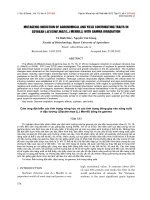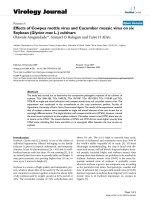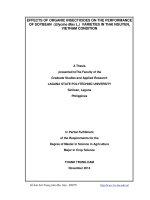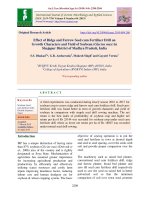Analysis of quantitative traits and estimation of heritability in early generations of a single cross in soybean (Glycine max (L.) Merrill)
Bạn đang xem bản rút gọn của tài liệu. Xem và tải ngay bản đầy đủ của tài liệu tại đây (483.6 KB, 7 trang )
Vietnam Journal
of Agricultural
Sciences
ISSN 2588-1299
VJAS 2018; 1(3): 201-207
/>
Analysis of Quantitative Traits and
Estimation of Heritability in Early
Generations of a Single Cross in Soybean
(Glycine max (L.) Merrill)
Vu Thi Thuy Hang and Vu Dinh Hoa
Faculty of Agronomy, Vietnam National University of Agriculture, Hanoi 131000, Vietnam
Abstract
Genetic variability and heritability of quantitative traits, particularly
of yield contributing traits, are of great importance in understanding
phenotypic variation and the heritable portion of the variation when
making selection choices. In the present study, the heritability for
days to 50% flowering, days to maturity, plant height at maturity,
total number of pods per plant, number-filled pods per plant, 100seed weight, and grain yield per plant were estimated by variance
components from variance analysis of parents and F 2 and F2:3
progeny families derived from a single cross. Heritability estimates
were high for days to 50% flowering and 100-seed weight,
moderate for the number of pods per plant and number of filled
pods per plant, and low for seed weight per plant. These results
suggested that in the early segregating generations, direct selection
for seed size, plant height, and a number of pods per plant might be
more efficient than the direct selection for seed yield.
Keywords
Soybean (Glycine max (L.) Merrill), quantitative traits, heritability
Introduction
Received: March 6, 2017
Accepted: November 30, 2018
Correspondence to
ORCID
Vu Thi Thuy Hang
/>Vu Dinh Hoa
/>
/>
High seed yield is the primary aim of most soybean breeding
programs. As in many crops, the extent of genetic improvement
depends upon the genetic variability of the breeding population and
the efficiency of the selection schemes. Soybean breeding
techniques commonly exploit the genetic variability in segregating
populations developed from crosses of two or more parents
followed by individual plant selection. Variability in soybeans was
used to improve agronomic performance traits such as yield, seed
protein and oil content, and plant height, which enabled the
selection of new germplasm (Fasoula et al., 2007 a, b, c). When
utilized, variability can not only help improve yield and other
agronomic performance traits, but also help improve plant tolerance
201
Analysis of quantitative traits and estimation of heritability in early generations of a single cross in soybean
to stresses and global changes in the
environment. Thus, the presence and magnitude
of genetic variability in a population is a prerequisite of a breeding program (St. Martin,
1985; Bhat et al., 2012).
The genetic improvement of quantitative
characteristics,
particularly seed
yield,
however, is often more difficult due to their
polygenic
control
and
environmental
fluctuations, resulting in low heritability (Fehr,
1987; Burton, 1987; Coryell et al., 1999). As a
result, selection for yield per se may not be
rewarding unless other yield attributing traits
are taken into consideration, especially if the
individual components are highly heritable and
genetically independent (Aditya et al., 2011).
Thus, the estimation of different variance
components, particularly the heritability, would
provide information about the traits’
variability. Furthermore, the heritability of a
quantitative trait is very important to breeders
in understanding the heritable portion of the
total phenotypic variation, in choosing a
selection method, and in determining the
response to selection because it implies the
extent of transmissibility of traits to the next
generation. Further, heritability estimates are
helpful in knowing the performance of parents
in hybrids.
Heritability can be estimated by various
means, i.e. parent-offspring regression (Warner,
1952; Falconer and MacKay, 1996) and/or by
generation mean analysis (Warner, 1952;
Mather and Jinks, 1982). Genetic analyses in
soybean indicate that genetic variances and
heritability estimates vary largely depending on
the source populations/crosses and traits under
investigation. Studies in segregating populations
revealed that the heritability of plant seed
weight was low while the heritabilities of days
to maturity and plant height were high (Gomes
et al., 2004; Hakim et al., 2014; Hakim and
Suyamto, 2017).
The objectives of this study were to
determine the magnitude of genetic variability
and heritability of quantitative traits in F2 and
F2:3 progeny families derived from a single
soybean cross.
202
Materials and Methods
Plant materials
Soybean plants were selected from a
working collection specifically created for plant
height and plant seed yield made from a cross
between two soybean accessions, VI045032 and
GBVN004904, during the 2014 spring season.
The accession VI045032 (purple flower) was
introduced from AVRDC, and the accession
GBVN004904 (white flower) was obtained
from the Vietnam National Plant Resources
Center.
Cultural practices and trait measurements
Forty-two F2 plants from the cross were
grown in the spring of 2015. Twenty-seven F2
plants randomly selected to establish F2:3
progeny families were planted in the 2015
summer-autumn season in double row plots
with variable numbers of plants (18-30 plants)
per family depending on seed availability. The
two parents, VI045032 and GBVN004904, were
intercalated in duplicate. Row and intra-row
spacing was 40 and 15 cm, respectively.
Recommended cultural practices for growing
soybean were applied. The F2 generation and
F2:3 progeny family evaluations were conducted
at the Experimental Station of the Faculty of
Agronomy, Vietnam National University of
Agriculture. All plants in each family were
observed and measured for estimating genetic
parameters. The following traits were evaluated:
days to 50% flowering, days to maturity (only
for the F2 generation), plant height at maturity, a
total number of pods per plant, number of filled
pods per plant, 100-seed weight, and grain yield
per plant.
Quantitative trait analysis and estimation of
heritability
Data were analyzed using Microsoft Excel
(2010). The environmental variance, VE, was
estimated as the mean-variance among plants of
the two parents (VP1 +VP2)/2, after checking for
homogeneity of variance by Barlett’s test. The
broad-sense heritabilities of the traits in the F2
generation were estimated using the following
formula of Acquaah (2012):
Vietnam Journal of Agricultural Sciences
Vu Thi Thuy Hang and Vu Dinh Hoa (2018)
𝐻=
𝑉𝐹2− 𝑉𝐸
𝑘1 =
𝑉𝐹2
where H is the broad-sense heritability, VF2
is the total variance of the F2 generation, and VE
is the environmental variance.
The trait variances for each of the F2:3
progeny families were computed using
Microsoft Excel (2010) based on the following
statistical model:
Yij = µ + fi + eij,
where Yij is an observation of the jth plant of
the ith F2:3 family, μ is the grand mean of the
families or parents, fi is the genetic effect
attributed to the ith family, and eij is the effect
among plants within families or parents.
The original data of the number of pods per
plant and the number of filled pods per plant
were
transformed
using
square
root
transformations, √𝑥 + 0.5, to adjust the data to
the normal distribution curve (Costa et al.,
2008). The variance analysis for the F2:3
progeny families and for each parent is
presented in Table 1. Because of the different
number of plants measured in each F2:3 family
and each parent, the value was adjusted as kf, k1,
and k2 representing the weighted averages of the
number of plants measured for the families,
parent P1, and parent P2, respectively, and were
calculated as described by Costa et al. (2008).
1
𝑘𝑓 =
𝑁− [ ∑ 𝑛𝑖2 ]
𝑁
𝑓−1
1
∑ 𝑛𝑖2 ]
𝑁1
𝑁1 − [
𝑝1−1
1
𝑘2 =
𝑁2 − [ ∑ 𝑛𝑖2 ]
2
𝑝2 −1
The variance components were estimated as
follows:
The total phenotypic variance among F2:3
progeny families
2
𝜎𝐴𝑓
=
𝑀𝑆𝐴𝑓 − 𝑀𝑆𝑊𝑓
𝑘𝑓
The environmental variance
1
2
2
𝜎𝑒2 = 2 (𝜎𝑒(𝑝𝑎𝑟𝑒𝑛𝑡1)
+ 𝜎𝑒(𝑝𝑎𝑟𝑒𝑛𝑡2)
)=
1 𝑀𝑆𝐴𝑝1 −𝑀𝑆𝑊𝑝1
2
(
𝑘1
+
𝑀𝑆𝐴𝑝2 −𝑀𝑆𝑊𝑝2
𝑘2
)
The genotypic variance
2
2𝐺 = 𝐴𝑓
− 2𝑒
Broad sense heritability
𝜎2
𝐻 = 𝜎 2𝐺
𝐴𝑓
Results
Variability and heritability of the traits in the
F2 generation
The range of the F2 family means of the
cross indicates the variability that might be
expected in the progeny of a cross between two
accessions. Among the traits studied, plant
height at maturity, number of pods per plant,
number of filled pods per plant, and seed weight
Table 1. Analysis of variance for each trait measured in the F 2:3 progeny families
Source of variation
DF
Mean square
Expected mean square
Among families
f-1
MSAf
2Wf + kf2Af
Within families
N-f
MSWf
2Wf
Among plots
p1-1
MSAp1
2Wp1 + k12Ap1
Within plots
N1-p1
MSWp1
2Wp1
Among plots
p2-1
MSAp2
2Wp2 + k12Ap2
Within plots
N2-p2
MSWp2
2Wp2
For F3 families
For parent P1
For parent P2
Note: f = number of F 2:3 progeny families, p 1 = number of parent 1 replications, p 2 = number of parent 2 replications, N = total number of
plants in the F 2:3 progeny families observed, N 1 = total number of plants for parent 1, N 2 = total number of plants for parent 2.
/>
203
Analysis of quantitative traits and estimation of heritability in early generations of a single cross in soybean
Table 2. Estimates of range, mean, coefficient of variation, and of broad-sense heritability of yield contributing traits in the F2 generation
Range
Mean
Coefficient of
variation (%)
Broad-sense
heritability
Plant height at maturity (cm)
12.5-53.5
26.9
42.36
0.50
Days to 50% flowering
45.0-58.0
44.8
15.40
0.86
Days to maturity
94.0-113.0
99.1
4.09
0.88
Pod number per plant
15.0-108.0
43.1
48.87
0.20
Filled pod number per plant
15.0-106.0
41.8
50.08
0.23
100-seed weight (g)
11.8-21.2
17.4
11.84
0.79
Seed weight per plant (g)
3.6-32.1
13.8
47.77
0.23
Trait
per plant showed the widest ranges and had the
highest coefficients of variation (> 40%); while
days to 50% flowering, 100-seed weight, and,
particularly, days to maturity had lower
variabilities (Table 2). These results indicated
that plant height at maturity, number of pods,
number of filled pods, and seed weight per plant
were highly variable in the F2 generation.
Days to 50% flowering, days to maturity,
and 100-seed weight had high heritability
estimates of 0.86, 0.88, and 0.79, respectively
(Table 2). Plant height at maturity had moderate
heritability, but the yield components (number
of pods and number of filled pods per plant) and
seed weight per plant had low heritability (0.200.23). This indicated that days to 50%
flowering, maturity, and seed size were highly
heritable.
Variability and heritability of the traits in the
F2:3 progeny families
The range of the F2:3 progeny families
demonstrated the variability within each trait to
some degree, but the means for plant height at
maturity, days to 50% flowering and maturity,
number of pods per plant, number-filled pods
per plant, and 100-seed weight were very close
to the mid-parent values, while the mean for
seed weight per plant was not (Table 3). All the
F2:3 progeny families from the present single
cross had average plant seed yields exceeding
both parents. Although no statistical test was
conducted, one would expect that the difference
is significant because of the fairly large number
of observations involved in the means.
The heritability estimates were high for
plant height at maturity, days to 50% flowering,
a number of pods and number of filled pods per
plant, and 100-seed weight (Table 4). These
heritability estimates were comparable with
those reported by Costa et al. (2008). In
contrast, the seed weight per plant was of lowmoderate heritability (0.42) (Table 4). Although
the heritabilities in this study might be slightly
overestimated due to a rather limited number of
F2 and F2:3 progeny families, they indicated that
most of the yield contributing traits resulting
from a single cross are highly heritable and can
be successfully selected for in an early
segregating generation.
Table 3. Range and means of measured traits for the parents and F2:3-progeny families
Plant height
at maturity
(cm)
Days to
50%
flowering
Days to
maturity
Pod number
per plant
Filled pod
number per
plant
100-seed
weight (g)
Seed weight
per plant (g)
VI045032
29.3
40.9
108
28.50
25.57
27.91
7.71
G72
32.6
36.2
100
50.95
46.54
10.34
7.03
23.8-42.4
36.2-41.2
100-111
32.3-71.4
29.9-67.5
14.5-22.3
8.6-16.3
32.50
38.45
104.22
46.97
43.29
17.31
10.50
Parent or
F2:3 family
F2:3 family range
Mean
204
Vietnam Journal of Agricultural Sciences
Vu Thi Thuy Hang and Vu Dinh Hoa (2018)
Table 4. Genotypic variance, environmental variance, and broad-sense heritabilities of measured traits in the F 2:3 progeny families
Trait
VG(F2:3)
VE
Broad-sense heritability (H)
Plant height at maturity
33.244
6.332
0.84
Days to 50% flowering
2.242
0.859
0.73
Pod number per plant
1.224
0.199
0.86
Filled pod number per plant
100-seed weight
Seed weight per plant
1.108
0.211
0.84
136.168
16.641
0.89
1.767
2.447
0.42
Discussion
Estimates of heritability vary with each
trait, population, and environment under study.
Most studies have reported that seed yield was
relatively low in heritability (Anand and Torrie,
1963; Toledo et al., 2000; Gomes et al., 2004;
Costa et al., 2008; Bhat et al., 2012; Hakim and
Suyamto, 2017; Kuswantoro et al., 2018), while
plant height and days to maturity had moderate
to high heritability (Gomes et al., 2004; Hakim
et al., 2014; Hakim and Suyamto, 2017;
Kuswantoro et al., 2018). For segregating
populations following hybridization, heritability
estimates depend on the parents used to make a
cross, the handling of segregating generations
during the stabilization phase, traits, and the
generation per se. Anand and Torrie (1963),
from studies using F3 and F4 generations from
three soybean crosses, reported that heritability
estimates for seed yield and number of pods per
plant were relatively low whereas the estimates
for seed weight were high. Toledo et al. (2000)
studied F2, F3, F7, F8, F9, and F10 generations
derived from six biparental crosses made from
four cultivars and evaluated in 17 environments.
Their results showed that the heritability for
seed yield differed among cross combinations,
years and, sowing dates (0.09-0.55), and the
overall heritability was rather low (0.29).
Gomes et al. (2004) also found that the
heritabilities of days to maturity, plant height,
and seed yield differed among crosses and
generations, and, particularly, the general mean
heritability estimate of all crosses for seed yield
in the F6 generation (0.58) was higher than
those in the F6:7 (0.21) generation.
Studies with 25 soybean genotypes (Malik
/>
et al., 2006) and with 91 soybean lines
(Sulistyo et al., 2017) showed that the
heritabilities of 100-seed weight, days to 50%
flowering, days to maturity, plant height, and
grain yield per plant were high, and the authors
concluded that these traits were governed by
the additive type of gene action. Aditya et al.
(2011) estimated the genetic variability of 31
soybean genotypes and found high heritability
for days to 50% flowering, number of primary
branches per plant, plant height, 100-seed
weight, and seed yield per plant. Seed weight
has also been shown to be rather high in
heritability (Osekita and Olorufemi, 2014;
Kuswantoro et al., 2018; Joshi et al., 2018). In
the present study, heritability estimates for the
number of pods and number of filled pods per
plant in the F2 generation differed from the F2:3
generations, of which the heritabilities were
low in F2 but rather high in F2:3 . High
heritabilities were estimated for days to 50%
flowering, days to maturity, and 100-seed
weight in both the F2 and F2:3 generations,
while heritability for plant height at maturity
was moderate in F2 and high in F2:3 . Seed yield,
however, was low in heritability in both
generations. This is in contrast to that reported
by Osekita and Olorufemi (2014) who found
that the heritability for seed yield in an F 3
population was extremely high (0.98). The
high heritabilities of plant height at maturity,
days to maturity, and 100-seed weight in both
the F2 and F2:3 generations in this study suggest
that selection for these traits in early
generations may be effective. In contrast, low
heritability in seed yield and variable
heritabilities of the yield components indicate
that selection should be delayed to advanced
generations among recombinant lines.
205
Analysis of quantitative traits and estimation of heritability in early generations of a single cross in soybean
Conclusions
High heritability is an indication of the
presence of higher proportions of fixable
additive variance in the population. The
estimates of heritability when accompanied by
high genetic advances are meaningful for
breeders to design selection methods to be
followed. Among the quantitative traits studied
in the F2 and F2:3 progeny families derived from
a single cross of soybean in the present study,
days to 50% flowering and 100-seed weight had
consistently high heritability. However, the
plant height showed moderate heritability, and
the heritability for a number of pods per plant
and number of filled pods per plant varied with
generation. The heritability of seed weight per
plant was of low heritability in both the F2 and
F3 generations. This indicates that direct
selection for seed yield in early generations
would be less effective while selection for seed
size, and probably plant height and number of
pods per plant, might be more efficient. To
make correct decisions for applying selections
in segregating generations of soybeans derived
from
crosses,
narrow-sense
heritability
estimations might be of necessity.
Acknowledgements
The authors wish to thank Vietnam
National University of Agriculture (VNUA) for
financial support through the VNUA Key
Project on Soybean Improvement Program.
References
Acquaah J. (2012). Principles of genetics and plant
breeding, 2nd ed. Wiley Blackwell. pp. 64-94.
Aditya J. P., Bhartiya P. and Bhartiya A. (2011). Genetic
variability, heritability and character association for
yield and component characters in soybean (G. max
(L.) Merrill). Journal of Central European
Agriculture. Vol 12. pp. 27-34.
Anand S. C. and Torrie J. H. (1963). Heritability of yield
and other traits and interrelationships among traits in
the F3 and F4 generations of three soybean crosses.
Crop Science. Vol 3 (6). pp. 508-511.
Bhat S., Basavaraja G. T. and Salimath P. M. (2012).
Analysis of variability in segregating generation of
soybean [Glycine max (L.) Merrill]. Karnataka Journal
of Agricultural Sciences. Vol 25. pp. 176-178.
206
Burton J. W. (1987). Quantitative genetics: results
relevant to soybean breeding. In: Wilcox J. R. (Ed.).
Soybeans: Improvement, Production and Uses, 2nd ed.
Agronomy Monograph 16. ASA, CSSA and SSSA:
Madison Wisconsin. pp. 211-247.
Coryell V. H., Jessenm H., Schupp J. M., Webb D. and
Keim P. (1999). Allele-specific hybridisation markers
for soybean. Theoretical and Applied Genetics. Vol
98. pp. 690-696.
Costa M. M., Di Mauro A. O., Uneda-Trevisoli S. H.,
Arriel N. H. C., Barbaro I. M., Silva G. D. D. and
Munze F. R. S. (2008). Heritability estimation in
early generations of two-ways crosses in soybean.
Bragantia. Vol 67. pp. 101-108.
Falconer D. S. and Mackay T. F. C. (1996). Introduction
to quantitative genetics, 4th ed. Longman Group.
London, UK.
Fasoula V. A., Boerma H. R., Yates J. L., Walker D. R.,
Finnerty S. L., Rowan G. B. and Wood E. D. (2007a).
Registration of five soybean germplasm lines selected
within the cultivar ‘Benning’ differing in seed and
agronomic traits. Journal of Plant Registrations. Vol
1. pp. 156-157.
Fasoula V. A., Boerma H. R., Yates J. L., Walker D. R.,
Finnerty S. L., Rowan G. B. and Wood E. D. (2007b).
Registration of seven soybean germplasm lines
selected within the cultivar ‘Cook’ differing in seed
and agronomic traits. Journal of Plant Registrations.
Vol 1. pp. 158-159.
Fasoula V. A., Boerma H. R., Yates J. L., Walker D. R.,
Finnerty S. L., Rowan G. B. and Wood E. D. (2007c).
Registration of six soybean germplasm lines selected
within the cultivar ‘Haskell’ differing in seed and
agronomic traits. Journal of Plant Registrations. Vol
1. pp. 160-161.
Fehr W. R. (1987). Breeding methods for cultivar
development. In: Wilcox J. R. (Ed). Soybeans:
Improvements, Production and Uses. ASA,
Wisconsin. pp. 249-294.
Gomes R. L. F., Vello N. A. and De Azevedo Filho J. A.
(2004). Genetic analysis of F6 and F6:7 soybean
generations. Crop Breeding and Applied Biotechnology.
Vol 4. pp. 35-42.
Hakim L., Suyamto E. P. and Paturohman E. (2014).
Genetic variability, heritability and expected genetic
advances of quantitative characters in F2 progenies of
soybean crosses. Indonesian Journal of Agricultural
Science. Vol 15. pp. 11-16.
Hakim L. and Suyamto E. P. (2017). Gene action and
heritability estimates of quantitative characters among
lines derived from varietal crosses of soybean genetic
variability, heritability and expected genetic advances
of quantitative characters in F2 progenies of soybean
crosses. Indonesian Journal of Agricultural Science.
Vol 18. pp. 25-32.
Joshi D., Pushpendra, Singh K. and Adhikari S. (2018).
Study of genetic parameters in soybean germplasm
Vietnam Journal of Agricultural Sciences
Vu Thi Thuy Hang and Vu Dinh Hoa (2018)
based on yield and yield contributing traits.
International Journal of Current Microbiology and
Applied Sciences. Vol 7 (1). pp. 700-709.
Kuswantoro H., Artari R., Rahajeng W., Ginting E.
and Supeno A. (2018). Genetic variability,
heritability and correlations of some agronomical
characters of soybean varieties. Biosaintfika. Vol
10 (1). pp. 9-15.
Mather K. and Jinks J. L. (1982). Biometrical genetics, 3rd
ed. Chapman and Hall, London.
Malik M. F. A., Qureshi A. S., Ashraf M. and Ghafoor A.
(2006). Genetic variability of the main yiled related
characters in soybean. International Journal of
Agriculture and Biology. Vol 8. pp. 815-819.
Osekita O. S. and Olorunfemi O. (2014). Quantitative
genetic variation, heritability and genetic advance in
the segregating F3 populations in Soybean (Glycine
max (L.) Merril. International Journal of Advanced
/>
Research. Vol 2 (7). pp. 82-89.
St. Martin S. K. (1985). The application of quantitative
genetics theory to plant breeding problems. In:
Proceedings of the World Soybean Research
Conference III, pp. 305-310.
Sulistyo A., Purwantoro A. and Sari K. P. (2017).
Correlation, path analysis and heritability estimation
for agronomic traits contributing to yield in soybean,
International Symposium on Food and Agrobiodiversity (IFSA) 2017. doi:10.1088/17551315/102/1/012034, 6 pages.
Toledo J. F. F., Arias C. A. A., Olivera M. F., Triller C.
and Miranda Z. F. S. (2000). Genetical and
environmental analyses of yield in six two-way
soybean crosses. Pesquisa Agropecuária Brasileira,
Brasília. Vol 35 (9). pp. 1783-1796.
Warner J. N. (1952). A method for estimating heritability.
Agronomy Journal. Vol 44. pp. 427-430.
207









